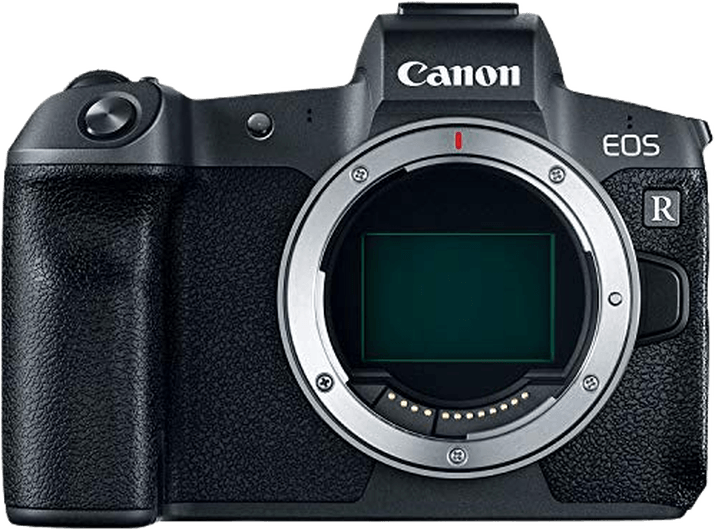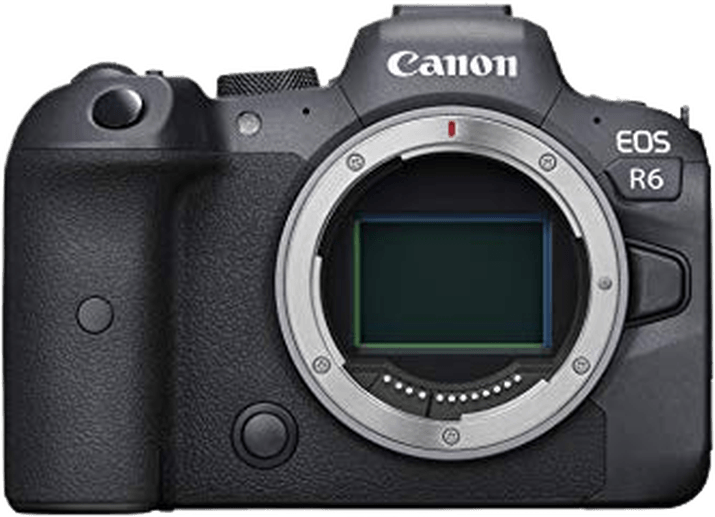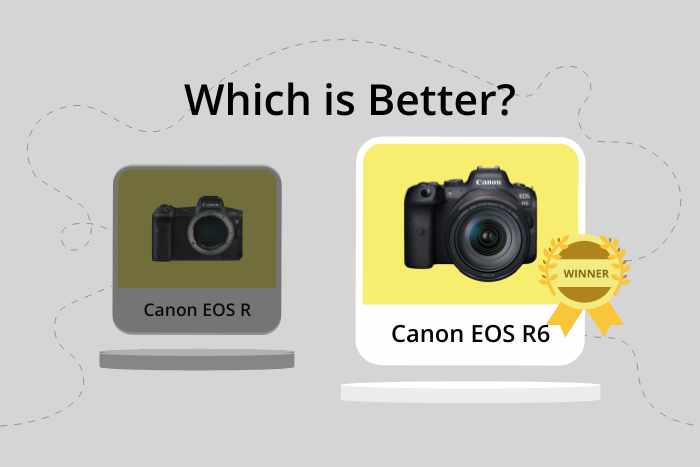Canon EOS R vs EOS R6 Comparison
Canon EOS R

Canon EOS R6

The Canon EOS R6 outperforms the Canon EOS R with a score of 80/100, compared to the latter’s 74/100. Both cameras are mirrorless and share similar dimensions, with the EOS R6 being slightly larger at 138 x 98 x 88mm and heavier at 680g. The EOS R is lighter, weighing 485g and measuring 136 x 98 x 84mm.
The EOS R6 has an advantage in its more recent release year of 2020, while the EOS R was launched in 2018. This newer model justifies its higher launch price of $2499, compared to the EOS R’s $2300. The EOS R, however, may appeal to those seeking a more compact and lightweight option.
Considering these factors, the Canon EOS R6 is a better camera due to its higher score, reflecting its more advanced features and performance. The Canon EOS R remains a viable choice for those prioritizing size and weight.
Canon EOS R vs EOS R6 Overview and Optics
The Canon EOS R6 is the winner in the optics comparison, scoring 79/100, while the Canon EOS R scores 73/100. Both cameras share several specifications, including sensor type (CMOS), sensor size (Full Frame), and lens mount (Canon RF). However, there are differences that contribute to the R6’s higher score.
The Canon EOS R6 has a faster shooting speed of 20, compared to 8 for the EOS R. This allows the R6 to capture more images in a shorter amount of time, making it more suitable for fast-paced situations and action shots. Additionally, the R6 has a Digic X processor, while the EOS R uses a Digic 8 processor. The Digic X processor provides faster processing and better overall performance.
Another advantage of the R6 is its image stabilisation, which the EOS R lacks. This feature helps to reduce camera shake and improve image sharpness, especially in low light conditions or when using longer focal lengths.
In contrast, the Canon EOS R has a higher megapixel count at 30.3, compared to 20.1 for the R6. This means the EOS R can capture more detail and produce larger prints. However, the R6 has a slightly better DXOMARK score for the sensor (90 versus 89), which means the image quality is not significantly compromised despite the lower megapixel count.
Considering these factors, the Canon EOS R6 emerges as the superior choice in terms of optics, due to its faster shooting speed, better processor, and image stabilisation. The EOS R, on the other hand, offers a higher megapixel count, which may be more appealing for those prioritising image detail and larger prints.
Canon EOS R vs EOS R6 Video Performance
The Canon EOS R6 outperforms the Canon EOS R in video capabilities, with a video score of 91/100 compared to the EOS R’s score of 70/100. Both cameras share common specifications, such as 4K max video resolution and 3840 x 2160 max video dimensions. Additionally, both cameras have built-in time-lapse functionality.
The EOS R6 surpasses the EOS R in its max video frame rate, offering 120fps compared to the EOS R’s 30fps. This significant difference enables the R6 to capture smoother, more detailed footage, particularly in fast-paced or action-filled scenes. The increased frame rate allows for better slow-motion capabilities, providing users with more creative flexibility in their video projects.
While the EOS R cannot compete with the R6’s higher frame rate, it still offers respectable video performance with its 4K resolution and 30fps. For those who primarily focus on photography and only require basic video capabilities, the EOS R may be a more cost-effective option.
Considering these factors, the Canon EOS R6 is the clear winner in terms of video performance, thanks to its impressive 120fps max video frame rate. This makes it an ideal choice for videographers and content creators who require advanced video capabilities. On the other hand, the Canon EOS R remains a viable option for those who prioritize photography and only need essential video features.
Canon EOS R vs EOS R6 Features and Benefits
The Canon EOS R triumphs over the Canon EOS R6 with a feature score of 87/100, compared to the R6’s 85/100. Despite their close scores, both cameras have several shared specifications.
Both the Canon EOS R and EOS R6 possess a touchscreen, flip screen, WIFI, and Bluetooth capabilities. Additionally, neither camera has GPS functionality. These similarities make the cameras user-friendly and easily connected to other devices.
The Canon EOS R outshines the R6 with a larger screen size of 3.2 inches and a higher screen resolution of 2,100,000 dots. This difference allows for better image viewing and handling when capturing or reviewing photos.
The Canon EOS R6, despite its slightly lower feature score, still offers valuable features. It has a 3-inch screen size and a screen resolution of 1,620,000 dots. While these specifications are lower than the EOS R, the R6 remains a viable option for photographers who prioritize compactness and affordability over a larger screen and higher resolution.
After examining the shared and differing features, it is clear that the Canon EOS R’s larger screen size and higher screen resolution contribute to its higher score. However, the Canon EOS R6’s slightly smaller screen size and lower resolution may be preferable for some photographers who prioritize compactness and affordability. Both cameras offer user-friendly features, making them excellent choices for various photography needs.
Canon EOS R vs EOS R6 Storage and Battery
The Canon EOS R6 outperforms the Canon EOS R in storage and battery, scoring 68/100 compared to the EOS R’s 35/100. Both cameras share similarities in storage capabilities, accepting SD, SDHC, and SDXC memory cards with UHS-II compatibility. Additionally, both models support USB charging.
The EOS R6 possesses a notable advantage with its dual memory card slots, offering increased storage capacity and flexibility. However, the EOS R slightly surpasses the R6 in battery life, providing 370 shots compared to the R6’s 360 shots. Despite this, the R6 utilizes a more advanced battery type, the LP-E6NH, which may offer improved performance and longevity.
Considering these factors, the Canon EOS R6 holds a clear edge in storage capacity due to its dual card slots, while the EOS R maintains a minor advantage in battery life. Nonetheless, the R6’s superior battery type and overall higher score make it the preferable choice for photographers seeking better storage and battery performance.
Canon EOS R vs EOS R6 Alternatives
If you’re still undecided (or just curious!) check out some other popular camera comparisons:

